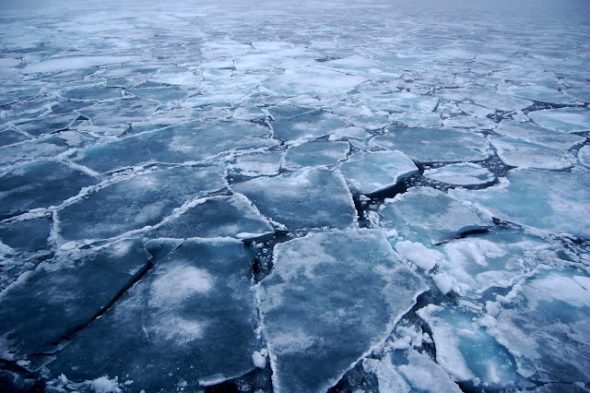A new study links the past decade’s “exceptional number of unprecedented summer extreme weather events” in the US and Europe with the “record declines in both summer Arctic sea ice and snow cover on high-latitude land.” Researchers at the Chinese Academy of Sciences, along with Rutgers Prof. Jennifer Francis, make the case in a Nature Climate Change study, “Extreme summer weather in northern mid-latitudes linked to a vanishing cryosphere” (subs. req’d).

Global warming reduces the temperature difference between the equator and poles, which in turn has been linked to the observed northward shift in the jet stream. Via Climate Central.
Scientists predicted a decade ago that Arctic ice loss would shift storm tracks and bring on worse western droughts of the kind we are now seeing. Recent studies find that Arctic sea ice loss may well usher changes in the jet stream that lead to more US extreme weather events (see here and here).
We’ve known for a long time that global warming melts highly reflective white ice and snow, which is replaced by the dark blue sea or dark land, both of which absorb far more sunlight and hence far more solar energy. That is one of the many sources of “polar amplification,” whereby the Arctic warms much faster than other parts of the globe. Now it seems increasingly clear that the amplified Arctic warming in turn amplifies extreme weather by shifting and weakening the jetstream (see video here).
The new study notes that in the past three decades, Arctic sea ice extent during late summer has fallen some 8 percent per decade, while spring snow coverage in June has fallen some 18 percent percent per decade. The researchers “combine satellite observations of early summer snow cover and summer sea-ice extent with atmospheric reanalysis data” to shown a linkage between those snow and ice losses and mid-latitude summer weather patterns:
Atmospheric changes associated with the combined snow/ice reductions reveal widespread upper-level height increases, weaker upper-level zonal winds at high latitudes, a more amplified upper-level pattern, and a general northward shift in the jet stream. More frequent extreme summer heat events over mid-latitude continents are linked with reduced sea ice and snow through these circulation changes.
Some climatologists I spoke to believe the case has not been fully made. They argue that the recent period of the most significant ice/snow loss and most extreme weather is too short to draw statistically significant conclusions. And Kevin Trenberth of National Center for Atmospheric Research told Climate Central, “There is no plausible physical mechanism or analysis of how the atmosphere is forced to behave in this manner.”
Still, as the National Oceanic and Atmospheric Administration (NOAA) explained in an October 2012 news release:
The effects of Arctic amplification will increase as more summer ice retreats over coming decades. Enhanced warming of the Arctic affects the jet stream by slowing its west-to-east winds and by promoting larger north-south meanders in the flow. Predicting those meanders and where the weather associated with them will be located in any given year, however, remains a challenge.
The researchers say that with more solar energy going into the Arctic Ocean because of lost ice, there is reason to expect more extreme weather events, such as heavy snowfall, heat waves, and flooding in North America and Europe but these will vary in location, intensity, and timescales.
This effect is all but certain to become even larger in the next decade or two (see Experts Warn ‘Near Ice-Free Arctic In Summer’ In A Decade If Volume Trends Continue).
John Mason at Skeptical Science has put together a primer, “A Rough Guide to the Jet Stream: what it is, how it works and how it is responding to enhanced Arctic warming.” He concludes, “Evidence is mounting to indicate that the response of the jet stream to” polar amplification “has been to tend to slow down and meander more, with a greater tendency to develop blocking patterns,” which in turn prolong and intensify all sorts of extreme weather events. We are only just beginning to sort out the implications of this for key global concerns, such as food security.
This article was originally published on Climate Progress. Reproduced with permission







